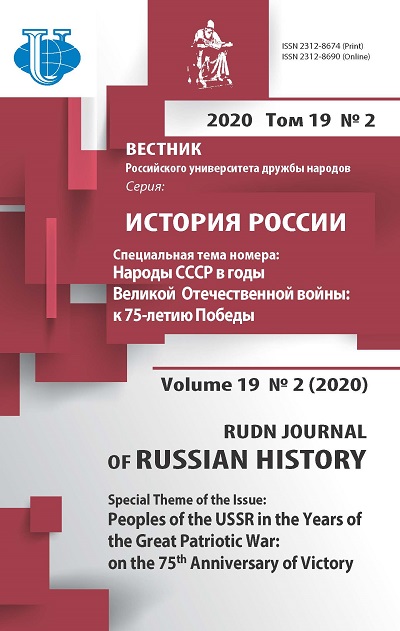The Ethnic Aspect in Red Army Recruitment During the Great Patriotic War: A Historical and Statistical Review
- Authors: Bezugolny A.Y.1
-
Affiliations:
- Scientific Research Institute of Military History of Military Academy of the General Staff of the Armed Forces of Russia
- Issue: Vol 19, No 2 (2020): PEOPLES OF THE USSR IN THE YEARS OF THE GREAT PATRIOTIC WAR: ON THE 75th ANNIVERSARY OF VICTORY
- Pages: 298-319
- Section: PEOPLES OF THE USSR IN THE YEARS OF THE GREAT PATRIOTIC WAR: ON THE 75th ANNIVERSARY OF VICTORY
- URL: https://journals.rudn.ru/russian-history/article/view/23773
- DOI: https://doi.org/10.22363/2312-8674-2020-19-2-298-319
Cite item
Full text / tables, figures
Abstract
Due to the multi-ethnic nature of our state, the ethnic factor has always been important in the recruitment, organization and combat use of the Russian armed forces. The deeper the ethnocultural, especially linguistic differences of the personnel, the more urgent was the need for a special organization of military service of the non-Russian contingent. The article is devoted to the analysis of ethnic processes in the Red Army during the Great Patriotic War of 1941-1945. Much attention is given to the dynamics of the quantitative and specific representation of Soviet ethnic groups during the war, the reasons for the reduction or, on the contrary, the expansion of this representation. The research is based on normative and policy documents that regulated mobilization and conscription work, as well as office documents that reflect the execution of state decisions. Among the latter, the author has identified a set of accounting and statistical materials of the central organizational and mobilization institutions of the People's Commissariat of Defense of the USSR. The scientific novelty of the presented research is that for the first time the ethnonational aspect of the history of the red army during the Great Patriotic War was analyzed using quantitative research methods. This made it possible to significantly deepen the understanding of the ethnic processes taking place in the Soviet armed forces.
Full text / tables, figures
Figure 1. Change in the headcount of the Red Army in 1939–1945 (person)
Figure 2. The share of Ukrainians in the Red Army units from 1939 to 1945 (in percent)
Figure 3. The dynamics of the number of Russian troops in the ranks of the Red Army from July 1943 to January 1945
About the authors
Alexey Yu. Bezugolny
Scientific Research Institute of Military History of Military Academy of the General Staff of the Armed Forces of Russia
Author for correspondence.
Email: besu111@yandex.ru
Kandidat Istoricheskikh Nauk [PhD in history], Leading Researcher at Scientific Research
14, University Av., Moscow, 119330, RussiaReferences
- Artem'yev, A.P. Bratskiy boyevoy soyuz narodov SSSR v gody Velikoy Otechestvennoy voyny. Moscow: Mysl' Publ., 1975 (in Russian).
- Alexiev, R., and Wimbush, S.E. The Ethnic Factor in the Soviet Armed forces. Historical Experience, Current Practices, and Implications for the Future. Santa Monica: Rand, 1983.
- Blauvelt, T.K. “Military Mobilisation and National Identity in the Soviet Union.” War & Society 21, no. 1 (2003): 41–62.
- Curran, S.L., and Ponomareff, D. Managing the Ethnic Factor in the Russian and the Soviet Armed forces: An Historical Overview. Santa Monica: Rand, 1982.
- Daugherty, III L.J. “Ethnic minorities in soviet armed: The plight of central Asians in a Russiandominated military.” The Journal of Slavic Military Studies 7, no. 2 (1994): 155–197.
- Gor'kov, Yu.A. Gosudarstvennyy Komitet Oborony postanovlyayet (1941–1945): Tsifry, dokumenty. Moscow: OLMA-PRESS Publ., 2002 (in Russian).
- Lobinger, J.H. Minority Nationalities in the Soviet Armed Forces. Oklahoma: University of Oklahoma, 1973.
- Rakowska-Harmstone, T. Red Army as an Instrument of National Integration. Carlisle Barracks: US Army War College, 1978.
- Rakowska-Harmstone, T. “Brotherhood in Arms”: The Ethnic Factor in the Soviet Armed Forces.” In Ethnic Armies: Polyethnic Armed Forces from the Time of the Habsburgs to the Age of the Superpowers, 123–157. Waterloo: Wilfrid Laurier University Press, 1990.
- Rybchenko, L.V. “Radyansʹki viysʹkovi mobilizatsiyi 1943 roku.” In Storinky voyennoyi istoriyi Ukrayiny, 103–112. Kyyiv: Instytut istoriyi Ukrayiny NAN Ukrayiny Publ., 2009 (in Ukrainian).
- Rybchenko, L.V. “Dokumentalʹnyy fond z obliku lyudsʹkykh vtrat Natsionalʹnoho muzeyu istoriyi Velykoyi Vitchyznyanoyi viyny 1941–1945 rokiv yak dzherelo z vyvchennya problemy radyansʹkykh viysʹkovykh mobilizatsiy 1943–1944 rokiv.” In Naukovi zapysky. Zbirnyk pratsʹ molodykh vchenykh ta aspirantiv, 129–139. Kyyiv: Instytut istoriyi Ukrayiny NAN Ukrayiny, 2009 (in Ukrainian).
- Rybchenko, L.V. “Personalʹnyy oblik lyudsʹkykh viysʹkovykh vtrat Chervonoyi armiyi u Velykiy Vitchyznyaniy viyni.” In Kyyivsʹki adresy spovishchenʹ pro zahybelʹ: doslidzhennya, dokumenty, svidchennya, 60–97. Kyyiv: Instytut istoriyi Ukrayiny NAN Ukrayiny Publ., 2013 (in Ukrainian).
- Sanborn, J.A. Drafting the Russian nation. Military conscription, total war, and mass politics, 1905–1925. Illinois: Northern Illinois University Press, 2003. Sukhar', M.Ya. Voyenno-mobilizatsionnaya rabota Sredne-Aziatskogo voyennogo okruga, respublik Sredney Azii i Kazakhstana po podgotovke mobilizatsionnykh rezervov v gody Velikoy Otechestvennoy voyny (1941–1945 gg.). Ashkhabad: [S.n.], 1981 (in Russian).
- Zhiromskaya, V.B., Kiselev, I.N., and Polyakov, Yu.A. Vsesoyuznaya perepis' naseleniya 1939 goda. Moscow: Nauka Publ., 1996 (in Russian).
Supplementary files
















